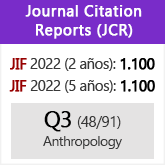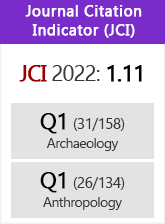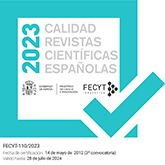El ámbar de la Cueva de los Cuarenta (Priego de Córdoba, Córdoba)
DOI:
https://doi.org/10.3989/tp.2018.12219Palabras clave:
Ámbar, FTIR, Neolítico, Estudios de Procedencia, Intercambios, Mediterráneo, Península IbéricaResumen
La presencia de objetos exóticos en contextos arqueológicos y los intercambios a larga distancia que estos implican es uno de los temas que despierta más interés en la discusión arqueológica. En este artículo presentamos el estudio de una cuenta o colgante hallado en contextos neolíticos de la Cueva de los Cuarenta (Priego de Córdoba). Se trata del único elemento de adorno presente en la cueva, en la que se ha documentado un número mínimo de 41 inhumaciones datadas a lo largo del IV milenio cal ANE. Se presenta la información contextual del hallazgo así como su caracterización arqueométrica mediante Espectroscopía de Infrarrojos por Transformada de Fourier (FTIR). El análisis de la pieza muestra que se trata de una cuenta de ámbar realizada con material foráneo, similar al empleado en las producciones de ámbar posteriores como las de Valencina de la Concepción (Sevilla). Al igual que en estos casos, se propone la procedencia exógena de la materia prima empleada, siendo Sicilia el origen más plausible a día de hoy, lo cual contribuirá al debate sobre las implicaciones que estos materiales foráneos pudieron tener en las sociedades prehistóricas peninsulares.
Descargas
Citas
Alonso, J.; Arillo, A.; Barrón, E.; Carmelo Corral, J.; Grimalt, J.; López, J. F; … y Trincão, P. R. 2000: "A new fossil resin with biological inclusions in Lower Cretaceous deposits from Álava (Northern Spain, Basque-Cantabrian Basin)". Journal of Paleontology 74 (1): 158-178. https://doi.org/10.1017/S0022336000031334
Álvarez-Fernández, E.; Pe-alver, E. y Declòs, X. 2005: "La presencia de ámbar en los yacimientos prehistóricos (del Paleolítico Superior a la Edad del Bronce) de la Cornisa Cantábrica y sus fuentes de aprovisionamiento". Zephyrus 58: 147-170.
Angelini, I. y Bellintani, P. 2016: "The use of different amber sources in Italy during the Bronze Age: new archaeometric data". Archaeological and Anthropological Sciences 9: 673-84. https://doi.org/10.1007/s12520-016-0452-7
Beck, C. W. 1982: "Physical methods used to determine the geological origin of amber and other fossil resins; some critical remarks: comments". Physics and Chemistry of Minerals 8: 146-147. https://doi.org/10.1007/BF00311286
Beck, C. W. y Hartnett, H. E. 1993: "Sicilian amber". En C. W. Beck y J. Bouzek (eds.): Amber in Archaeology. Proceedings of the 2nd International Conference on Amber in Archaeology (Liblice 1990). Institute of Archaeology of the Czech Academy of Sciences. Praga: 36-47.
Beck, C. W.; Wilbur, E. y Meret, S. 1964: "Infra-red spectra and the origin of amber". Nature 201: 256-257. https://doi.org/10.1038/201256a0
Beck, C. W.; Wilbur, E.; Meret, S.; Kossove, D. y Kermani, K. 1965: "The infrared spectra of amber and the identification of Baltic amber". Archaeometry 8: 96-109. https://doi.org/10.1111/j.1475-4754.1965.tb00896.x
Bronk-Ramsey, C. y Lee, S. 2013: "Recent and planned developments of the program Oxcal". Radiocarbon 55 (2-3): 720-730. https://doi.org/10.1017/S0033822200057878
Cerde-o, M. L.; Martínez, J. F.; Agua, F.; Sagardoy, T. y Monasterio, M. 2012: "Ámbar en la meseta oriental durante el Bronce Final: yacimientos locales e importaciones bálticas". Trabajos de Prehistoria 69 (2): 375-384. https://doi.org/10.3989/tp.2012.12098
Costa Caramé, M. E.; García Sanjuán, L.; Murillo-Barroso, M.; Parrilla Giráldez, R. y Wheatley, D. 2011: "Rocas raras en los contextos funerarios del IV-II milenios cal. ANE en el Sur de Espa-a: una revisión". En L. García Sanjuán, C. Scarre y D. W. Wheatley (eds.): Exploring time and matter in prehistoric monuments: absolute chronology and rare rocks in European megaliths. Proceedings of the 2nd European Megalithic Studies Group Meeting (Seville, Spain 2008). Menga. Revista de Prehistoria de Andalucía Monográfico 1: 253-293.
Cultraro, M. 2007: "Evidence of amber in Bronze Age Sicily: local sources and the Balkan-Mycenaean connection". En I. Galanaki, H. Tomas, Y. Galanakis y R. Laffineur (eds.): Between the Aegean and Baltic Seas. Prehistory across borders. Proceedings of the International Conference: Bronze and Early Iron Age interconnections and contemporary developments between the Aegean and the regions of the Balkan Peninsula, Central and Northern Europe. (Zagreb 2005). Université de Liège. Liège: 377-390.
Domínguez-Bella, S.; Álvarez Rodríguez, M. A. y Ramos Mu-oz, J. 2001: "Estudio analítico de las cuentas de collar de ámbar del dolmen de Alberite (Villamartín, Cádiz). Naturaleza química y mineralógica e implicaciones sobre su origen". En B. Gómez Tubío, M. A. Respaldiza y M. L. Pardo Rodríguez (eds.): III Congreso Nacional de Arqueometría: 621-30. Sevilla.
Domínguez-Bella, S. y Bóveda Fernández, M. J. 2011: "Variscita y ámbar en el Neolítico gallego. Análisis arqueométrico del collar del túmulo I de Chousa Nova, Silleda (Galicia)". Trabajos de Prehistoria 68 (2): 369-80. https://doi.org/10.3989/tp.2011.11075
Domínguez-Bella, S. y Morata Céspedes, D. 1995: "Aplicación de las técnicas mineralógicas y petrológicas a la arqueometría. Estudio de materiales del dolmen de Alberite (Villamartín, Cádiz)". Zephyrus XLVIII: 129-42.
Fernández Flores, Á.; García Sanjuán, L. y Díaz-Zorita Bonilla, M. (eds.) 2016: Montelirio. Un gran monumento megalítico de la Edad del Cobre. Consejería de Cultura de la Junta de Andalucía. Sevilla.
Freund, K. P.; Tykot, R. H. y Vianello, A. 2017: "Contextualizing the Role of Obsidian in Chalcolithic Sicily (c. 3500 - 2500 BC)". Lithic Technology 42 (1): 35-48. https://doi.org/10.1080/01977261.2017.1290335
García Sanjuán, L. y Murillo-Barroso, M. 2013: "Social complexity in Copper Age southern Iberia (ca. 3200-2200 cal. B.C.): Reviewing the 'state' hypothesis at Valencina de la Concepción (Seville, Spain)". En M. Cruz Berrocal, L. García Sanjuán y A. Gilman (eds.): The Prehistory of Iberia: debating early social stratification and the state. Routledge. New York: 119-140.
García Sanjuán, L. y Wheatley, D. 2010: "Natural substances, landscape forms, symbols and funerary monuments: Elements of cultural memory among the Neolithic and Copper Age societies of southern Spain". En K. Lillios y V. Tsamis (eds.): Material mnemonics: everyday memory in prehistoric Europe. Oxbow. Oxford: 10-39.
Gomez, B.; Bamford, M. y Martínez-Declòs, X. 2002: "Lower Cretaceous plant cuticles and amber (Kirkwood Formation, South Africa)". Comptes Rendus Palevol 1 (2): 83-87. https://doi.org/10.1016/S1631-0683(02)00014-3
Guiliano, M.; Asia, L.; Onoratini, G. y Mille, G. 2007: "Applications of diamond crystal ATR FTIR spectroscopy to characterization of ambers". Spectrochimica Acta, Part A, 67: 1407-11. https://doi.org/10.1016/j.saa.2006.10.033 PMid:17129753
Harrison, R. J. y Gilman, A. 1977: "Trade in the second and third millennia B.C. between the Magreb and Iberia". En V. Markotic (ed.): Ancient Europe and the Mediterranean. Studies presented in honour of Hugh Hencken. Aris y Phillips. Warminster: 90-114.
Kerig, T. y Shennan, S. (eds.) 2015: Connecting networks. Characterising contact by measuring lithic exchange in the European Neolithic. Archaeopress. Oxford.
Khanjian, H., Schilling, M. y Maish, J. 2013: "FTIR and Py-Gc/Ms Investigation of Archaeological Amber Objects from the J. Paul Getty Museum". e-Preservation Science 10: 66-70.
Murillo-Barroso, M. 2016: "Capítulo 13. El ámbar del Tholos de Montelirio". En Á. Fernández Flores, L. García Sanjuán y M. Díaz-Zorita Bonilla (eds.): Montelirio. Un gran monumento megalítico de la Edad del Cobre. Consejería de Cultura de la Junta de Andalucía. Sevilla: 311-344.
Murillo-Barroso, M. y Martinón-Torres, M. 2012: "Amber sources and trade in the Prehistory of the Iberian Peninsula". European Journal of Archaeology 15 (2): 187-216. https://doi.org/10.1179/1461957112Y.0000000009
Murillo-Barroso, M. y Montero Ruiz, I. 2017: "The social value of things. Amber and copper in the Iberian Chalcolithic". En M. Bartelheim, P. Bueno Ramírez y M. Kunst (eds.): Key resources and socio-cultural developments in the Iberian Chalcolithic. Tübingen Library Publishing. Tübingen: 273-290.
Murillo-Barroso, M.; Pe-alver, E.; Bueno, P.; Barroso, R.; de Balbín, R. y Martinón-Torres, M. 2018: "Amber in Prehistoric Iberia: New data and a review". PLoS ONE 13 (8): e0202235. https://doi.org/10.1371/journal.pone.0202235 PMid:30157208 PMCid:PMC6114727
Najarro, M.; Pe-alver, E.; Rosales, I.; Pérez-de la Fuente, R.; Daviero- Gómez, V.; Gómez, B. y Delclòs, X. 2009: "Unusual concentration of Early Albian arthropod-bearing amber in the Basque-Cantabrian Basin (El Soplao, Cantabria, Northern Spain): Palaeoenvironmental and palaeobiological implications". Geologica Acta 7 (3): 363-387.
Pe-alver, E. y Delclòs, X. 2010: "Spanish Amber". En D. Penney (ed.): Biodiversity of Fossils in Amber from the Major World Deposits. Siri Scientific Press. Manchester: 236-270.
Pe-alver, E.; Álvarez-Fernández, E.; Arias, P.; Declòs, X. y Onta-ón, R. 2007: "Local amber in a Paleolithic context in Cantabrian Spain: the case of La Garma A". Journal of Archaeological Science 34: 843-849. https://doi.org/10.1016/j.jas.2006.03.006
Pe-alver, E.; Delclòs, X. y Soriano, C. 2007: "A new rich amber outcrop with paleobiological inclusions in the Lower Cretaceous of Spain". Cretaceous Research 28: 791-802. https://doi.org/10.1016/j.cretres.2006.12.004
Rovira i Port, J. 1994: "Ámbar y pasta vítrea. Elementos de prestigio entre el neolítico avanzado y el Bronce Final del Nordeste de la Península Ibérica. Un primer estado de la cuestión". Quaderns de Prehistòria i Arqueologia de Castelló 16: 67-91.
Schlüter, T. y Gnielinski, F. von 1986: The East African copal. Its geologic, stratigraphic, palaeontologic significance and comparison with fossil resins of similar age. National Museums of Tanzania. Occasional Paper N. 8.
Schmidt, A. R.; Perrichot, V.; Svojtka, M.; Anderson, K. B.; Belete, K. H.; Bussert, R.; …y Vávra, N. 2010: "Cretaceous African life captured in amber". Proceedings of the National Academy of Sciences of the United States of America 107 (16): 7329-7334. https://doi.org/10.1073/pnas.1000948107
Schuhmacher, X. T.; Cardoso, J. L. y Banerjee, A. 2009: "Sourcing African ivory in Chalcolithic Portugal". Antiquity 83: 983-997. https://doi.org/10.1017/S0003598X00099294
Skeates, R. 2010: "The art of memory: personal ornaments in Copper Age south-east Italy". En K. Lillios y V. Tsamis (eds.): Material mnemonics. Everyday memory in Prehistoric Europe. Oxbow. Oxford: 73-84.
Tykot, R. H. 1995: Prehistoric trade in the Western Mediterranean: the sources and distribution of Sardinian obsidian. Universidad de Harvard. Boston.
Tykot, R. H.; Freund, K. P. y Vianello, A. 2013: "Source analysis of Prehistoric obsidian artifacts in Sicily (Italy) Using pXRF". En R. A. Armitage y J. H. Burton (eds.): Archaeological chemistry VIII, American Chemical Society Symposium Series 1147. American Chemical Society. Washington DC: 195-210. https://doi.org/10.1021/bk-2013-1147.ch011
Valdiosera, C.; Güntherb, T.; Vera-Rodríguez, J. C.; Ure-a, I.; Iriarte, E.; Rodríguez-Varela, R… y Jakobsson, M. 2018: "Four millennia of Iberian biomolecular prehistory illustrate the impact of prehistoric migrations at the far end of Eurasia". Proceedings of the National Academy of Sciences. https://doi.org/10.1073/pnas.1717762115
Vera Rodríguez, J. C. (ed.) 2014: "Dossier. La Cueva de los Cuarenta (Priego de Córdoba). Avance de los resultados de la Intervención Arqueológica de 2007". Antiquitas 26: 71-133.
Vera Rodríguez, J. C.; Casas Flores, M. J.; Martínez Sánchez, R. M.; Martínez Fernández, M. J.; Bretones García, M. D.; Morgado Rodríguez, A.; …y Lozano Rodríguez, J. A. 2014: "Los contextos sepulcrales de la Cueva de los Cuarenta. Arqueología de los gestos funerarios durante la segunda mitad del IV milenio BC en el subbético cordobés". En J. C. Vera Rodríguez (ed.): Dossier. La Cueva de los Cuarenta (Priego de Córdoba). Avance de los resultados de la Intervención Arqueológica de 2007. Antiquitas 26: 81-122.
Vijande Vila, E.; Domínguez-Bella, S.; Cantillo Duarte, J. J.; Martínez López, J. y Barrena Tocino, J. 2015: "Social inequalities in the Neolithic of southern Europe: The grave goods of the Campo de Hockey necropolis (San Fernando, Cádiz, Spain)". Comptes Rendus Palevol 14: 147-161. https://doi.org/10.1016/j.crpv.2014.11.004
Vilaça, R.; Beck, C. W. y Stout, E. C. 2002: "Provenience analysis of Prehistoric amber artifacts in Portugal". Madrider Metteilungen 43: 61-79.
Descargas
Publicado
Cómo citar
Número
Sección
Licencia
Derechos de autor 2018 Consejo Superior de Investigaciones Científicas (CSIC)

Esta obra está bajo una licencia internacional Creative Commons Atribución 4.0.
© CSIC. Los originales publicados en las ediciones impresa y electrónica de esta Revista son propiedad del Consejo Superior de Investigaciones Científicas, siendo necesario citar la procedencia en cualquier reproducción parcial o total.Salvo indicación contraria, todos los contenidos de la edición electrónica se distribuyen bajo una licencia de uso y distribución “Creative Commons Reconocimiento 4.0 Internacional ” (CC BY 4.0). Puede consultar desde aquí la versión informativa y el texto legal de la licencia. Esta circunstancia ha de hacerse constar expresamente de esta forma cuando sea necesario.
No se autoriza el depósito en repositorios, páginas web personales o similares de cualquier otra versión distinta a la publicada por el editor.

















